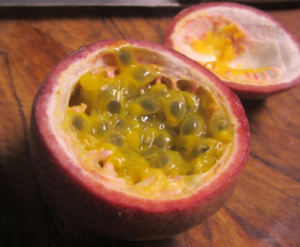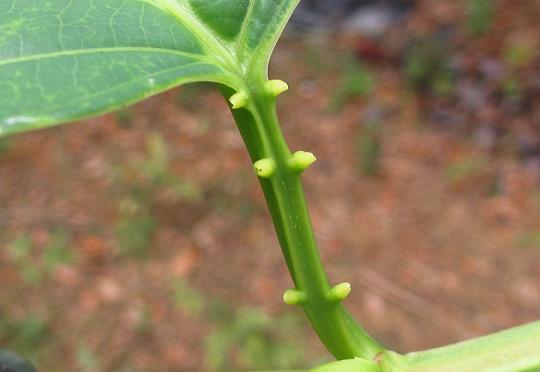Passion fruit is aptly named
If you are looking for a plant to cover a fence or a trellis in a very short time, then a passion fruit vine is what you want. Passiflora vines are very fast growing, and will cover anything climable faster than most people would believe possible.
I’ve seen a purple passionfruit completely cover thirty feet of fence in a single growing season. Of course, the downside to this is that they will rapidly cover things you may not want them to as well. The tendrils grab onto anything they can. If you were to stand next to one for long enough, they’d grab onto you too. The unusual flowers are showstoppers, and one vine can quickly produce hundreds of fruits in as little as one year. Passiflora edulis edulis will produce crops of fruit in the Spring as well as a smaller crop in the Fall. Passiflora eduls flavicarpa can produce from Spring through Fall.
It is truly one of my favorite plants in the world!
Out of all of the different species of Passiflora, the best species for fruit production is the purple passion fruit (Passiflora edulis). P. edulis is farmed throughout the tropics, for its delicious fruit.
The fruit itself is a bit odd, and contains numerous seeds, so it isn’t usually eaten out of hand, but the juice is in my opinion, one of the most delicious flavors in existence.
Passionfruit juice outshines orange juice, mango juice, guava nectar, or pretty much any other juice in complexity, and it is sweet and tangy as well.
Of course, I just love to spoon the pulp directly out of the fruit and into my mouth. I use my tongue to crush the pulp against the roof of my mouth and release the juice. Then I just swallow all of the seeds. I’ve found this to be the easiest way to eat them. If you have a juicer, you will love these.
Plants For Sale
No Results Found
The page you requested could not be found. Try refining your search, or use the navigation above to locate the post.
Passion Flower Varieties
The genus Passiflora contains 500 different species which are pantropically distributed. Interestingly, there are no members of the genus native to the African continent. The majority of the species are from Central and South America, Southeast Asia, and New Guinea. There are numerous hybrids grown for their showy flowers, and there are a great many different colors and forms to choose from. Some of them are breathtakingly gorgeous.
Many of the hybrids have cool growing Andean species in their parentage so that they can withstand colder climates, making them available to gardeners pretty much anywhere in the continental USA. The hybrids also tend to flower much more prolifically, which makes them very desirable for flower gardeners.
The hybrids are frequently sterile though, and since I’m mostly interested in the edible fruit, I only grow fruiting species.
North American Natives
There are several species native to North America, but most are not that showy or impressive. Passiflora incarnata is a notable exception to this. They have beautiful, large, light purple flowers, and they can be grown almost anywhere in North America. Freezing temperatures will kill the foliage but P. incarnata comes back from the roots every Spring. I know people who grow them in Canada. They pile mulch around the base of the vine in Fall, and they grow back and bloom in Spring.
Passionflowers and Butterflies
Most butterfly gardeners are very familiar with the relationship between butterflies and Passifloras, but the fruit gardeners are frequently surprised by how many zebra longwings, and gulf fritillarys they begin to see in their gardens. The initial delight of having these beautiful flying creatures in your yard, quickly sours when you discover that they are laying thousands of eggs on your plants. The hordes of voracious caterpilars to follow can devastate a passionfruit vine in a very short time.
If you want butterflies, then let them go to town, but if you want fruit then you have to eliminate the little guys. Manually removing the eggs and caterpillars works well, but it can be a daunting task if your vine is large (if your vine isn’t large it will be soon), so you might want to try using BT (Bacillus thuringiensis). BT is a pathogenic bacteria that only infects larvae of the order Lepidoptera.
It doesn’t adversely affect other insects, earthworms, or animals, and in my opinion is a much better alternative to using harsh pesticides.

Photo showing the egg mimicry on Passiflora quadrangularis petiole glands
The Passifloras and certain species of butterfly, have a long co-evolutionary relationship with one another. One interesting adaptation to result from this is the use of egg mimicry in Passifloras. Female butterflies won’t lay their eggs on leaves that already have another butterfly’s eggs on them.
They move on and find a better, less crowded spot. Some Passifloras have developed protuberances on their petiole that look just like butterfly eggs. These false eggs reduce the amount of eggs layed on the plant.
I’ve seen zebra longwings hopping from one petiole to the next looking for an appropriate place to lay their eggs, so this ruse does seem to have some beneficial effect for the plant.
The petiole glands also produce nectar. This is referred to as an extrafloral nectary. This is counter intuitive, as it would seem likely to attract butterflies, which would inevitably lay eggs on the plant, but the nectar produced, contains alkaloids that are offensive to butterflies. The purpose of these extrafloral nectaries is to attract ants that attack caterpillars.
Ironically, the same butterflies that use these plant as hosts for their larvae, are also largely responsible for pollinating the flowers. The nectaries located within the flower, produce a different nectar, devoid of the offensive alkaloids found in the petiole gland nectar. This nectar is appealing to the butterflies, and they come by the hundreds to visit the flowers when they are in bloom.
American Journal of Plant Sciences, 2013, 4, 460-469
